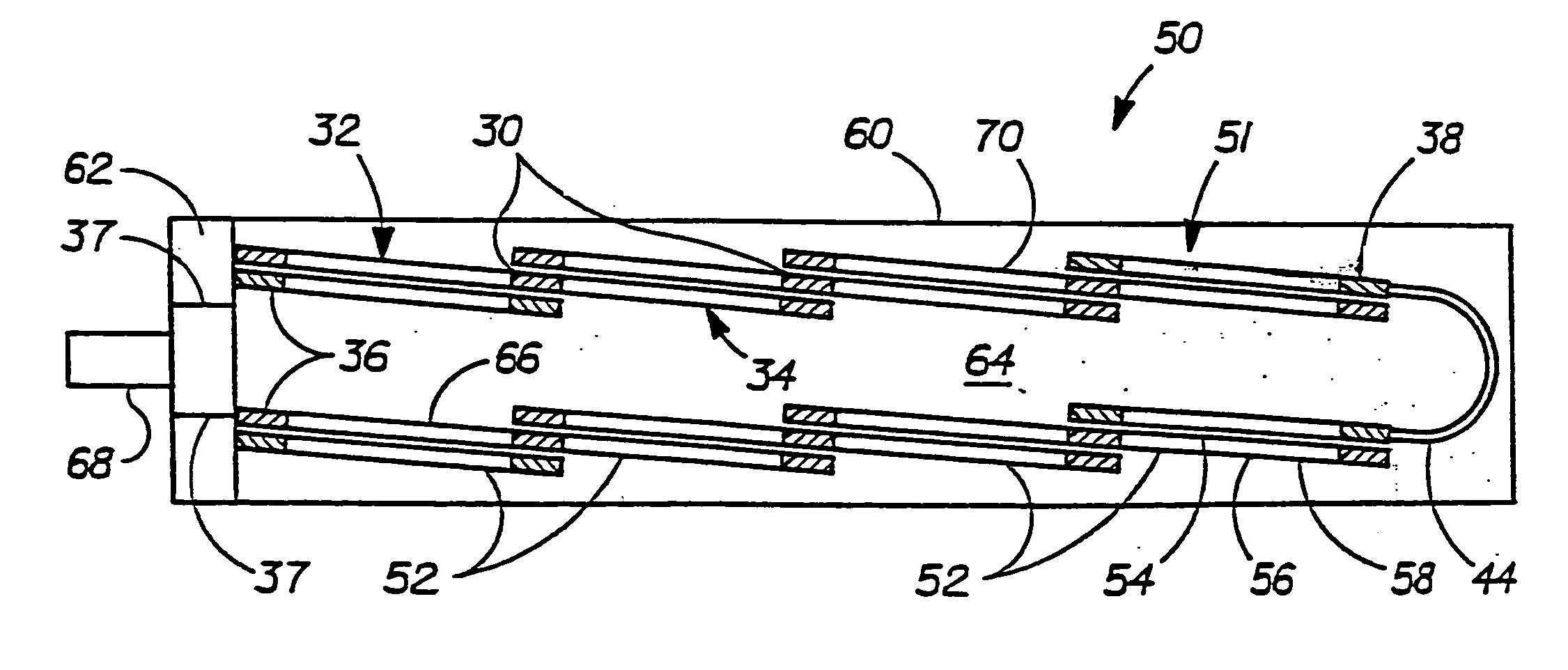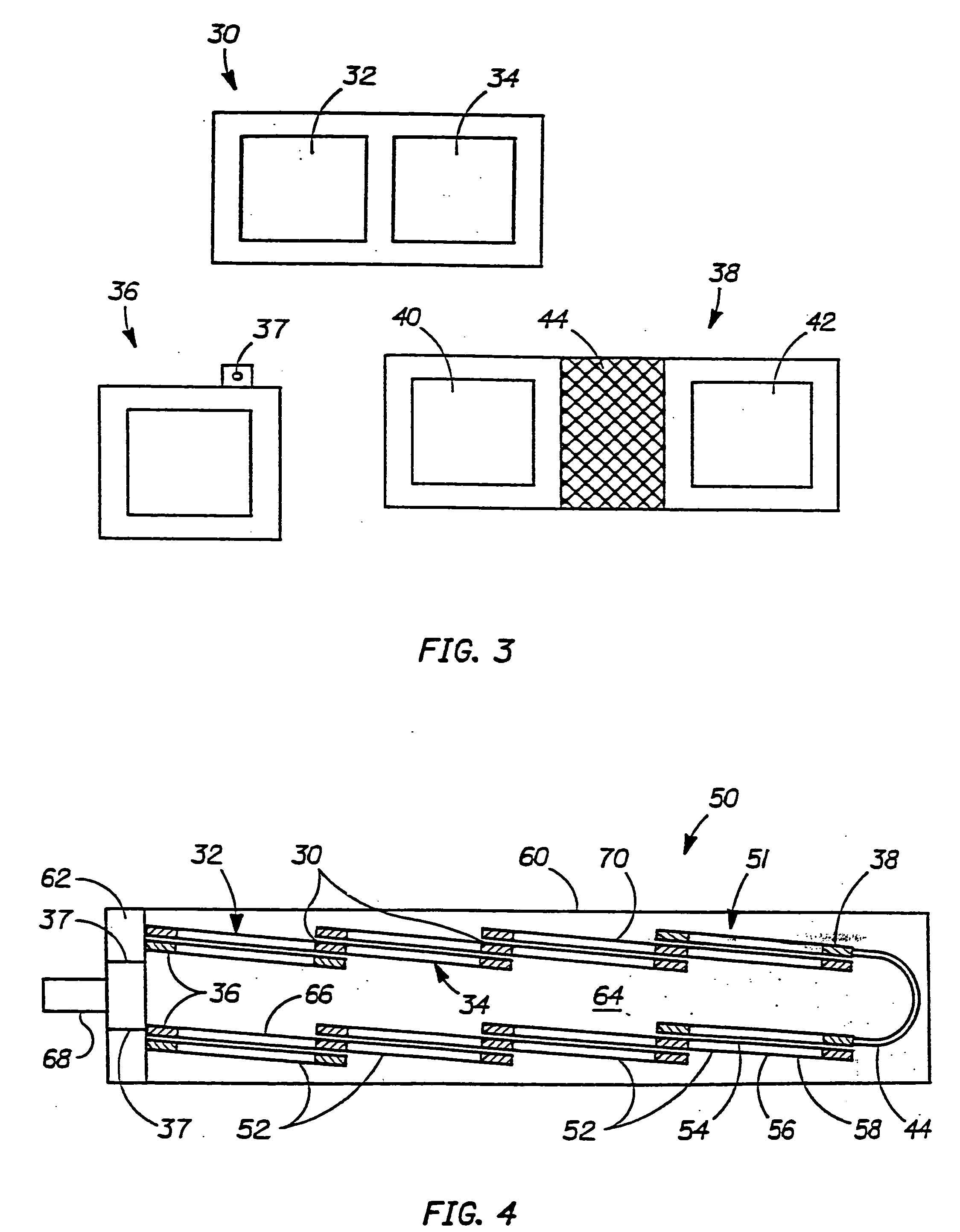Fuel cell system for low pressure operation
a fuel cell and low-pressure technology, applied in the field of low-pressure fuel cells, can solve the problems of large, heavy, and relatively complex overall systems that have evolved, and can not meet stack outputs in the tens or hundreds of watts, and small-scale systems of this design are too heavy for many small applications
- Summary
- Abstract
- Description
- Claims
- Application Information
AI Technical Summary
Problems solved by technology
Method used
Image
Examples
example 1
[0122] This example illustrates a gas diffusion electrode using carbon powder as the conductive material in the metal supported matrix.
[0123] A gas diffusion electrode was made by mixing Vulcan XC-72R high surface area carbon powder (available from CABOT Technology Division, Pampa, Tex.) with polytetrafluoroethylene “PTFE” suspension (such as T-30, available from DuPont, Wilmington Del.) in a 60:40 ratio (based on the dry weight of the PTFE), water, and a nonionic surfactant (such as Triton X100, available from Fisher Scientific, Fair Lawn, New Jersey). The carbon / PTFE mixture was sonicated to reach complete dispersion and the resulting paste was spread onto an expanded foil grid. This grid, fabricated from expanded copper foil, had previously been electroplated with a protective gold layer, through the use of a standard commercial gold electroplating both (E-56, from Engelhard, Corp., Iselin, N.J.) and serves as the grid to form a gas diffusion electrode.
[0124] The bulk of the wa...
example 2
[0125] This example illustrates a gas diffusion electrode using carbon fiber with carbon powder in the metal supported matrix.
[0126] The gas diffusion electrode was made by mixing Vulcan XC-72R high surface area carbon powder (CABOT) and Thornel™ DKD-X carbon fiber (Amoco Corp., Apharetta, Ga.) with PTFE suspension (T-30, DuPont), in a 52:17:31 ratio (based on the dry weight of the PTFE), water, and nonionic surfactant (Triton X100). The carbon / PTFE mixture was sonicated and fabricated into a metal supported gas diffusion electrode as described in example 1.
example 3
[0127] This example illustrates a gas diffusion electrode using carbon fiber with carbon powder in the metal supported matrix.
[0128] The gas diffusion electrode was made by mixing Vulcan XC-72R high surface area carbon powder (CABOT) and carbon fiber obtained by ball milling Toray TGP-H paper (Toray Corp., New York, N.Y.) with PTFE suspension (T-30, DuPont), in a 42:17:41 ratio (based on the dry weight of the PTFE), water, and nonionic surfactant (Triton X100). The carbon / PTFE mixture was sonicated and fabricated into a metal supported gas diffusion electrode as described in example 1.
PUM
| Property | Measurement | Unit |
|---|---|---|
| pressure | aaaaa | aaaaa |
| power | aaaaa | aaaaa |
| pressure | aaaaa | aaaaa |
Abstract
Description
Claims
Application Information
 Login to View More
Login to View More - R&D
- Intellectual Property
- Life Sciences
- Materials
- Tech Scout
- Unparalleled Data Quality
- Higher Quality Content
- 60% Fewer Hallucinations
Browse by: Latest US Patents, China's latest patents, Technical Efficacy Thesaurus, Application Domain, Technology Topic, Popular Technical Reports.
© 2025 PatSnap. All rights reserved.Legal|Privacy policy|Modern Slavery Act Transparency Statement|Sitemap|About US| Contact US: help@patsnap.com



